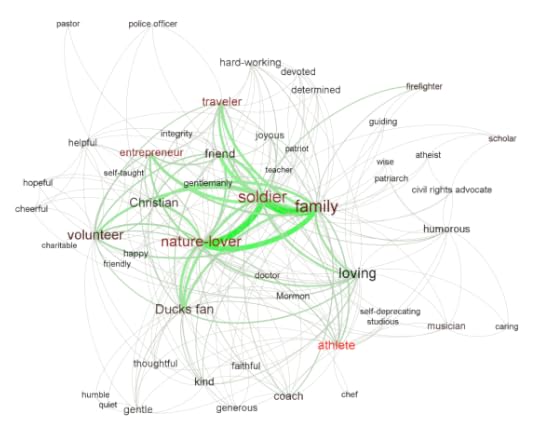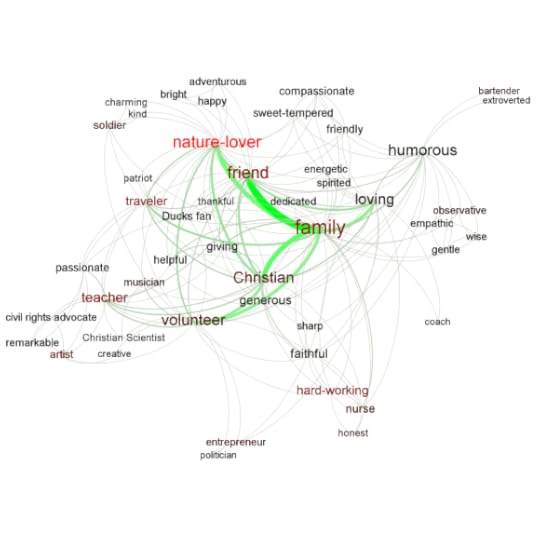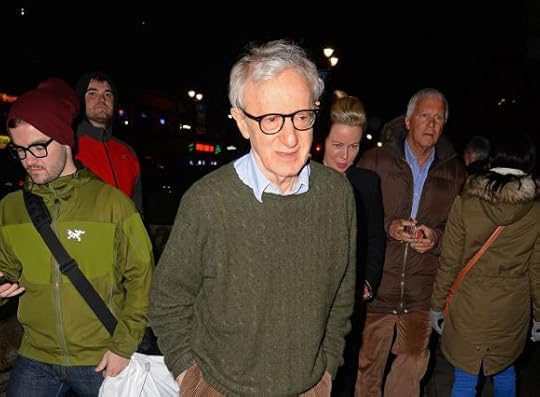Andrew Sullivan's Blog, page 371
February 3, 2014
A Conflicted Conflict Photographer
DL Cade captions the above video:
Don McCullin is a household name in the photographic community, but as far as he is concerned, it’s for all the wrong reasons. In this incredibly poignant and thought-provoking interview, he shares his thoughts about an illustrious career that was spent photographing atrocities, and left him somewhat haunted.
In a profile from last year, McCullin described the inspiration for his work:
“In my photography I always lean towards the underprivileged because that’s where I came from,” says McCullin. “When I went to the wars I attempted to go and stand by those who were being trodden on. By that I mean people like the Palestinians. When I go to India I see really the poorest people and I tend to be drawn to them. You could say they are life’s losers but it’s society that has categorised them as such and made them be lost.”



How We Speak Of The Dead
Philosopher Mark Alfano gets a sense of the gender divide:
As a first pass, I read through a month’s worth of obituaries from my local paper, the Eugene [Oregon] Register-Guard, and noted all of the agent-level descriptions and evaluations of the deceased. In other words, I ignored what was said about hospice workers (not that their work is unimportant – quite the contrary) and single actions of the deceased, recording only the words used to describe him or her as a whole person.
One thing I immediately noticed was that there were systematic differences in how the men and the women were described. Unsurprisingly, a huge proportion of the men had fought in World War II, and thus were described as soldiers. The women – not so much. This suggested that there might be other, more subtle, systematic differences. Andrew [Higgins, of the University of Illinois at Urbana-Champaign] took this initial batch of data and created semantic maps of the things said about the men and the women. [Above is] the one for men.
Women, on the other hand, were recalled as “humorous” more often than men – sorry Hitch:



What Makes Someone A Coward?
Linda Besner suggests that the idea of “‘cowardice’ … holds less water as our society becomes more considerate of the psychological factors—like anxiety—that compound our behaviour.” She contemplates the meaning of bravery in a society in which “we’ve come to celebrate admissions of fear”:
In a 2010 article in Psychology Today entitled “The Meaning of Courage,” psychologist Dr. Richard Zinbarg wrote of his patients, “I am constantly inspired by their courageous confrontation of their fears and anxieties.” Zinbarg argues that fear is a prerequisite for bravery; if a man runs into a burning house to save someone without feeling any fear, he writes, it’s not really a brave thing to do. His hypothetical man’s name is Jim, and in explaining Jim’s behaviour, Zinbarg writes: “Two possibilities that come to mind are either that Jim exhibited a lack of intelligence or that he didn’t perceive danger in this situation.” Not only is it not brave not to be afraid, it may actually mean that you’re dumb.
The new formulation—bravery consists in admitting to one’s fears—makes it possible for all of us to consider ourselves heroes. … But without a moral category of cowardice, are we really entitled to a category of bravery? The argument that Fear is Courage sounds unsettlingly Orwellian, and paves the way for the simple admission of fear to replace overcoming it. The emotional risks of facing one’s feelings matter; but an inward-looking process focussed on self-actualization is different from a sense of duty to the wider world. If cowardice consists in failing the collective, bravery may be said to inhere in taking personal risks for the greater good.



Faces Of The Day
Justin Crowe sets the scene:
Photographer Jedediah Johnson has a phobia of making out. In a similar way that a person may confront a fear of heights by skydiving, Johnson is confronting his fear by making out with lots of people and leaving brightly colored lipstick behind as evidence.
To prep each subject for their portrait Johnson applies bright pink lipstick to his lips and places his hand gently on their neck; he then shares a strange but intimate moment kissing them. A photo is snapped following the makeout session and the evidence of the mysterious moment is documented for viewers to imagine for themselves what the actual kiss was like. Johnson explains, “The kisses vary in length and intimacy. My subjects are all aware of what I’m going to do ahead of time, but in the moment of the kiss anything can happen. The lipstick mark I leave on my subjects invites viewers to imagine the circumstances surrounding the kiss.”
A less ominous portrait after the jump:
More of Johnson’s work here.



Kerry’s Mideast Peace Plan
Judis outlines it:
The agreement would permit between 75 and 80 percent of Israeli settlers in the West Bank through land swaps. What settlements would remain, and what Israel would cede was not discussed in the briefings, but it’s likely that large settlements like Maale Adumim, where the controversial Soda Stream is produced, will become part of Israel under the agreement. …
Palestinian refugees would receive some kind of compensation, but so would Jewish refugees who fled, and in many cases were forced to flee, places like Iraq Syria, and Egypt after 1947. (Estimates are that about 500,000 of these refugees settled in Israel between 1947 and 1972.) That provision, one of the Jewish leaders commented, was meant as a “sweetener” to the Israelis. The Palestinians would recognize Israel as the nation of the Jewish people, and the Israelis would recognize Palestine as the nation of the Palestinian people. But one critical issue was left vague and unresolved. The framework will not propose a way of dealing with the future of Jerusalem as the capital of Israel and Palestine. “That’s the biggie,” one person involved in the calls commented.
Adam Garfinkle doubts this effort will produce an agreement:
I hope this works, but I’m skeptical. My sense is that the sides are still about as far apart as ever on all the key issues. I’m disappointed to hear that Kerry buys into the recent Israeli demand that the Palestinians recognize Israel as a Jewish state, which strikes me as a gratuitous and costly addition to the negotiating burden. I’m happy in theory that the Palestinian side has apparently agreed to allow discussion of compensation for Jews who left Arab countries after 1947-48, but in practice this is liable to raise an enormous can of worms given the diversity of the historical cases, and, like the “Jewish” state business, raise the cost to Israel in other ways of getting a deal that is sound on security grounds.
Stephen Cook expects the settlement issue to get in the way:
Based on Judis’ reporting, 75 percent of the settlers would remain under Israeli sovereignty in the West Bank through land swaps along with a residual military presence in the Jordan Valley for anywhere from 3 to 10 years and a host of other security guarantees. What will become of the remaining settlers is left open to question. Still, that is a lot of people no matter what method is used to count the settlers. The Palestinians would be hard-pressed to like this deal, but their views do not actually matter much. The Israelis hold virtually every card, and given the configuration of Israeli politics where the right has brought down successive prime ministers, it is highly unlikely that the issue of continued settlements will hinge on whether Scarlett Johansson is hawking SodaStream or not.
Bob Dreyfuss doubts AIPAC has the strength to fight the plan:
First, the American Israel Public Affairs Committee tried, and utterly failed, to destroy President Obama’s critical diplomatic dialogue with Iran by pushing for a new economic sanctions bill that would have ended the US-Iran talks. Now, AIPAC will have to face a real, existential challenge, namely, the about-to-be-released “framework agreement” for the Israel-Palestine conflict, a framework developed by Secretary of State John Kerry over months of shuttle diplomacy into the region. If AIPAC hadn’t confronted the White House over Iran—and lost—it might have more muscle now to fight the Obama-Kerry plan for Israel-Palestine. Instead, AIPAC has alienated the White House and, no doubt, lost credibility with some members of Congress, especially in the Democratic Party, who’ve traditionally followed AIPAC’s lead on the Middle East.
Hassan Barari sees it as a lose-lose for Abbas:
Now, it is obvious that the Palestinian leader is in a dilemma. If he accepts that framework, he will face enormous Palestinian opposition and he will go down to history as a “sell out.” Nevertheless, if he turns down the framework deal, he will be blamed for the failure of Kerry’s effort. What makes matter worse for the Palestinian side is that even accepting the framework deal will not automatically lead to an independent Palestinian state with East Jerusalem as its capital. It can only be a means for extracting enormous concessions from the Palestinians without real quid pro quo. Long time observers of the Arab-Israeli conflict argue that the framework can only keep the negotiations on for yet another year without real success.



What’s The Point Of Learning French?
McWhorter urges Americans to drop their French classes and learn a more practical language:
One learns French to communicate with … who, exactly? Some will yearn to read Sartre and Molière; more power to them. But what about languages like Spanish and Chinese, which are useful to learn because we encounter them in everyday life? I have seen medical professionals just miss getting plum jobs in New York because a competitor happened to speak Spanish, and Chinese will be increasingly important in the business world. Arabic skills, meanwhile, are achingly needed on the geopolitical scene. It’s swell that knowing French allows you to ignore subtitles in the occasional art house film, but unclear why this would be considered a priority of childrearing.



Keystone’s Carbon Contribution
The State Department’s Environmental Impact Report on the Keystone XL pipeline, released on Friday, concludes that the project won’t have any significant effect on carbon emissions:
The pipeline, which would carry 830,000 barrels of oil per day from Alberta, Canada, to refineries on the Gulf coast, has been attacked as the release valve for the more carbon-intensive bitumen that is fueling Canada’s energy boom. While the heavy crude coming from the Alberta fields would release roughly 17 percent more carbon than the heavy crude it would displace from U.S. refineries, the report claims that Keystone “remains unlikely to significantly impact the rate of extraction in the oil sands, or the continued demand for heavy crude oil at refineries in the United States.” In short, the oil is coming out one way or another — it’s only a matter of how it travels.
Plumer digs into the report:
More specifically: The 830,000 barrels of oil that the pipeline would transport each day would add an extra 1.3 million to 27.4 million metric tons of carbon dioxide to the atmosphere each year. That’s a whole lot of carbon — it’s like putting an extra 250,000 to 5.5 million cars on the road. But the key question is how much of that oil would get burned anyway, even if the pipeline is blocked. And the State Department believes most of it will get produced regardless.
Joshua Green notices that the much-touted job creating effect of the pipeline isn’t expected to last long:
The State Department concluded that the project would create 42,100 temporary jobs during the two-year construction period. But the report says once the pipeline enters service, it will support only 50 U.S. jobs—35 permanent employees and 15 temporary contractors.
And Heather Smith points out that this report isn’t necessarily the final word:
The State Department, which prepared the EIR, is also due to release the results of an investigation by the Inspector General into the review’s first draft, which turned out to be written by a contractor who had also done work in the not-too-distant-past for TransCanada, the company that wants to build KXL. If the investigation finds a conflict of interest, the State Department may be forced to do an entirely new EIR.
The politics make approving or rejecting the pipeline a tricky call for Obama:
A group of big Democratic donors, including Esprit co-founder Susie Tompkins Buell and Taco Bell heir and Democracy Alliance head Rob McKay, have publicly pressured Obama to reject the pipeline. Billionaire Tom Steyer, who poured money to help Terry McAuliffe win the Virginia governor’s race last year, ran an anti-Keystone ad during the State of the Union and is expected to spend millions of dollars more.
But Obama isn’t running again and several moderate Senate Democrats, including Mary Landrieu, Mark Begich, Mark Pryor and Kay Hagan, already support building the pipeline. It’d take an anti-Obama talking point off the table and avoid the possibility of an international spat with Canada.
Greens also realistically have nowhere to go — even if disappointed on one issue, a Democratic president and Senate is far better than anything the GOP can offer them.
Chait sees blocking Keystone as a losing issue for environmentalists:
[Ryan] Cooper mockingly asks readers to envision a protest where organizers shout,“What do we want?” “More stringent carbon dioxide emission regulations on extant coal-fired power plants!” “When do we want it?’ “After the extraordinarily complicated rule-writing process over which the president has no direct control!” It certainly may be easier to get people excited about opposing a pipeline. It may also be hard to get people excited about favoring new regulations.
But if your goal is to limit greenhouse-gas emissions, you need to have a strategy designed to advance policies that limit greenhouse-gas emissions. Stopping Keystone doesn’t do that. EPA regulations would. Would blocking the Keystone pipeline make it easier for Obama to issue tough regulations on existing power plants, and to negotiate an international climate treaty in 2015 after such regulations bring us into compliance with our reduction targets? I don’t see how.
Ryan Cooper counters:
Now, it is true that fighting individual pipelines one by one is a pretty dumb strategy if one’s goal is stopping climate change by that method alone. Oil companies will always win in the end at that game. Of course, that has never ever been the long-term strategy for Bill McKibben (who knows all about EPA regulations, even mentioning them before Keystone in this piece) and the other Keystone activists. The point is to use Keystone as a coordination point to create political pressure on the administration to take more drastic action. In that, they’ve already succeeded.



The New Songs Of Sappho
Exciting news for all you classicists out there:
Fragments of two previously unknown poems by seventh-century Greek lyric poetess Sappho have been discovered on an ancient papyrus. An anonymous private collector owned the papyrus, which dates back to the 3rd century A.D. He showed the tattered fragments to Dr. Dirk Obbink, a classicist at Oxford University, who recognized its significance and asked for permission to publish it. Dr. Obbink’s article will appear in a scholarly journal this spring, but an online version of one of the poems is already available via the Guardian. The first of the two poems mentions “Charazos” and “Larichos,” the names given to Sappho’s brothers in the ancient tradition. The second poem is a fragment of a piece about unrequited love.
Tom Payne, who provides a translation of the first poem, marvels at its integrity:
What we have of Sappho has often survived because ancient critics and philologists quoted her, so that we have a word here and a line there. (This has a musical quality of its own: Hugh Kenner called it “the poesis of loss,” and Anne Carson evoked these beguiling gaps in her 2003 edition of Sappho: If Not, Winter.) This poem comes with nine lines of another one, which would have been exciting enough on their own – they show Sappho using words typical of her other poems such as longing and desire, and addressing Aphrodite.
It’s also exciting to have something like a story.
It is a formula of sorts, and its wish that her brother sail back safely from his mission is a frequent trope in the verse of the stormy ancient Mediterranean. But it has an urgency that makes us sense the real Sappho. … And that’s why new glimpses of Sappho will always be thrilling. It’s not just that it’s new ancient poetry; it’s poetry that the ancients loved because it felt so new.
Laura Swift, elated by the discovery, wonders what else is out there:
There are thousands of unpublished papyrus fragments in university collections. Many of them come from Greco-Roman settlements in Egypt, where the dry sands preserved discarded books and papers that would have rotted in the damp soil of Europe. Still, it’s rare to find something as substantial and as well preserved as this new discovery, and papyrologists often have to satisfy themselves with a few tattered lines. Undergraduates studying classical literature are often told the depressing statistic that at least 90 percent of it has been lost.
The thread that connects us to the ancient past is incredibly fragile, and it could be broken each time a medieval monk decided not to copy a text, a fire or flood destroyed a precious manuscript collection, or a book failed to make it onto a school syllabus. But if this papyrus survived, who knows what other lost gems may be waiting in libraries, archives, or tucked away in basements or attics?
(Image of “Saphhos’ poem “An Old Age” (lines 9-20). Papyrus from 3 cent. B.C.” – not one of the newly discovered texts – via Wikimedia Commons)



Malkin Award Nominee
“[Philip Seymour Hoffman's] self-inflicted death is yet another hallmark of the broken leftist culture that dominates Hollywood, enabling rather than preventing the loss of some of its greatest talents,” – Ben Shapiro, NRO.



February 2, 2014
Debating Woody Allen On Superbowl Sunday
The only thing I can infer with absolute certainty from the anguished letter Dylan Farrow has written to the New York Times is that she is expressing incandescent rage. I cannot know from a distance what exactly is the reason for that rage, but she hates her former step-father, Woody Allen, with an intensity completely compatible with child abuse, and hard to explain away entirely without it. You can see how truly she hates him from her opening and closing lines. These are sentences designed to do as much harm to Allen as he allegedly did to her – to pin the crime of child-rape onto every movie he has ever made, to obliterate his legacy as an artist by insisting that his entire oeuvre be viewed through the prism of his monstrousness. I can fully understand the impulse. Can’t you?
At first you think this is melodrama, but then you realize she is simply wielding the most lethal weapon she has:
What’s your favorite Woody Allen movie? Before you answer, you should know: when I was seven years old, Woody Allen took me by the hand and led me into a dim, closet-like attic on the second floor of our house. He told me to lay on my stomach and play with my brother’s electric train set. Then he sexually assaulted me. He talked to me while he did it, whispering that I was a good girl, that this was our secret, promising that we’d go to Paris and I’d be a star in his movies. I remember staring at that toy train, focusing on it as it traveled in its circle around the attic. To this day, I find it difficult to look at toy trains.
I’m not sure how, especially after reviewing the evidence Maureen Orth collected over twenty years ago, you manage not to believe Dylan Farrow – even though in every hugely dysfunctional family, there is more than one side. But the fact that Mia Farrow may be a few sandwiches short of a picnic doesn’t prove that Woody Allen isn’t a monster. And Farrow’s anguished yet vicious letter makes a lot of emotional sense coming after the Gold Globes’ celebration of Allen’s lifetime of achievement. Then there’s what we already know of Farrow’s behavior as a child:
Several times … while Woody was visiting in Connecticut, Dylan locked herself in the bathroom, refusing to come out for hours. Once, one of the baby-sitters had to use a coat hanger to pick the lock. Dylan often complained of stomachaches and headaches when Woody visited: she would have to lie down. When he left, the symptoms would disappear. At times Dylan became so withdrawn when her father was around that she would not speak normally, but would pretend to be an animal.
These are classic indicators of abuse – along with plenty of other eye-witnesses to Allen’s creepy behavior around the girl.
And yet Dylan Farrow will, I’m afraid, fail in this case.
Not entirely. Re-reading that Orth piece and absorbing that letter definitely impacts my view of Allen as a whole. It reminds me again of who this man is. Like when we’re watching a Polanski or a Gibson movie, there will always be, for most of us, a tinge of guilt, even distant complicity, in admiring the craft of a man whose predilection for relationships was with women utterly under his totalitarian control. But the brutal truth is: we will move on. His art and his craft is so extraordinary in its range and scope and creative integrity that it escapes the twisted psyche that gave birth to it. It does things for us as viewers and as human beings that can eclipse the reality Dylan Farrow wants smack-dab in front of our eyes.
In some ways, I wish this weren’t so. It would be a less fallen and compromised world. But the human mind can, alas, live quite fully in places where the practical moral conscience seems irrelevant. And so it is essential to understand Heidegger’s foul complicity in the Third Reich but impossible to reduce his world-historical genius to it. That T.S Eliot was a rancid anti-Semite does not, frustratingly, dilute the perfection of the Four Quartets, nor does Philip Larkin’s racism alter the triumph of Aubade. Jefferson’s thought and career, for that matter, will always elude the facts of his ownership of human beings and intercourse with some of them. Perhaps with less essential talents, the sins may more adequately define the artist. But that, in many ways, only makes the injustice worse. Those with the greatest gifts can get away with the greatest crimes.
We can and should rail against this, while surely also be realistically resigned to it. It struck me, for example, rather apposite that as the blogosphere is debating whether to boycott Woody Allen’s films in future because of this horrifying story, exponentially more people are tuning into the Superbowl to watch a game we now know will render many of its players mentally incapacitated in their middle ages and beyond. We know that this spectacle is based on the premise of brain damage for many of its participants, but we watch anyway. Reforms in the game that might change the number of concussions are resisted by the fans as ferociously as by the owners. And in the excitement of the game, such things are so easy to obliterate from our minds. We forget that this massive industry knew full well what they were doing and yet subjected human beings to this fate for years. They abused people’s bodies and minds for money – and now we are required to celebrate their entire cult en masse for one night.
I imagine the family of a former football player whose brain was turned into swiss cheese by this organization might find it as painful to watch the Superbowl as Dylan Farrow did to witness the Golden Globes. But we will watch anyway.
Humankind cannot bear very much reality. Or only so much. And only so often.
(Photo: Director Woody Allen is seen on February 1, 2014 in New York City. By NCP/Star Max/GC Images via Getty.)



Andrew Sullivan's Blog
- Andrew Sullivan's profile
- 153 followers








